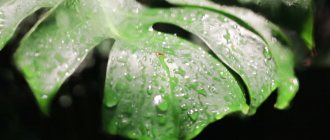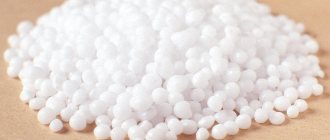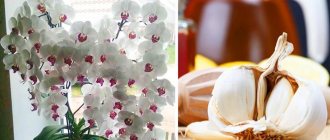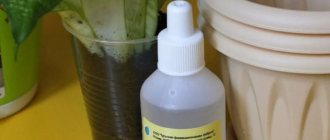What can we do to ensure that our favorite flowers on the windowsills are green, beautiful, and blooming wildly all year round? And the secret to a luxurious indoor flower garden is banally simple: the plants need to be well fed. You and I eat three times a day, so flowers need a varied diet.
Moreover, you can use homemade fertilizers for indoor flowers, which every housewife has, and it is not at all necessary to buy them in the store. One such remedy is feeding indoor flowers with aspirin. Aspirin - acetylsalicylic acid - is sold in every pharmacy at an affordable price. Few people know that it can be used not only for its intended purpose - for therapeutic purposes, but as a folk remedy for revitalizing, stimulating the growth and formation of buds in indoor plants.
Review of beautiful ornamental shrubs for cottages and gardens, names with photos
Using hedgehogs to process potatoes
Types of seedling cassettes and their use
How is aspirin useful for flowers?
Aspirin for indoor flowers is used in a wide variety of situations when you need to help house plants:
- The leaves are falling;
- New buds do not want to form;
- The appearance of home flowers began to deteriorate;
- After a stressful situation in the plant: transplantation or illness;
- For antifungal treatment.
Advice: please note that deterioration in the condition of flowers may be the result of improper care, disease or pest attack. In such cases, you need to take appropriate measures: aspirin alone is not enough.
Methods of application
There are only two ways to use aspirin solution on home flowers - experienced gardeners use both watering and spraying. Thus, aspirin is a type of root and foliar feeding.
For both methods you will need an aspirin solution; the recipe is very simple (read the answer to how to prepare it below). In the first case, the solution is simply poured under the roots in the normal watering mode, in accordance with the needs of the plant. That is, as with regular watering, cactus and hydrangea will require different quantities and regularity. Be sure to remember that an excess of moisture in the soil is just as unfavorable for plants as a lack of it.
The second method requires a spray bottle (as a last resort, you can simply take the solution into your mouth and spray it - it is harmless). You can either spray the leaves, flowers and buds directly, or practice distant spraying to increase humidity.
Any of the methods will have a beneficial effect on the health, development and flowering of house plants.
When to feed indoor flowers
If your plant has become elongated, the stems have become thin, if growth has stopped or slowed down, the leaves have turned pale, light spots have appeared on them, the plant refuses to bloom, then most likely it does not have enough nutrition.
But there is no need to bring the flowers to such a terrible state; they need to be fed regularly.
Already in March, when the sun begins to peep through the windows more and more often and the flowers begin to grow, you should start feeding them once every two weeks. And continue feeding in this mode until October.
Note to housewives
If you have been given a beautiful bouquet, and you really want it to last longer, it makes sense to turn to the medicine cabinet. Just drop one aspirin tablet into a vase of cut flowers. It has been proven in practice that they will last several times longer this way. And, of course, a simple and cheap drug will allow the plants to recover, regain their healthy appearance and continue to decorate the interior of your home.
Feeding indoor flowers with sugar
Almost any indoor flower responds well to the addition of glucose, which in sufficiently large quantities is used to form molecules and ensures normal development of the plant.
Using sugar fertilizer is very simple: you simply scatter grains of sand over the surface of the soil and water it, or once every 30 days add sweet syrup made from one teaspoon of sugar and 1 liter of settled water to the flowers. Ficuses and cacti will be especially grateful for such fertilizer.
Advantages and disadvantages of acid
It is necessary to use acetylsalicylic or ascorbic acid in watering indoor plants for several important reasons:
- stimulation of the growth of new shoots;
- activation of green mass growth;
- stimulation of budding and approaching the flowering phase;
- to combat stressful situations (after transplantation, vaccination, illness, etc.);
- for alkalizing the soil (especially important for plants that prefer acidic soil: rhododendrons, ferns, azaleas, bonsai conifers, etc.)
- for antiseptic effects and prevention of infection by pathogenic microflora.
Fertilizing indoor flowers with yeast
It is recommended to fertilize indoor flowers using yeast three times a year: with the arrival of spring (when moving to another place of growth or just for good growth), in summer (in order to improve the quality of flowering) and in autumn.
To get the most positive result, you can supplement the yeast with potassium and calcium hidden in the same ash.
A one percent yeast extract will look like this: 10 g of live yeast must be poured with a liter of water and completely dissolved, then water the plants once a year (preferably in the spring).
A solution consisting of 200 g of yeast and 1 liter of water, which after infusion is additionally diluted in 10 liters of water, is well suited as an alternative option for feeding.
How to keep fresh flowers longer using soda and bleach?
There are several ways to extend the life of flowers longer. For these purposes you will need some rather strange products. It is best to use lemonade and bleach.
How to keep fresh flowers longer using soda and bleach:
- You need to add a little sweet soda to melted or purified water in a 3:1 ratio. Next, add three drops of bleach, which contains chlorine, to this mixture. It's best if it's something like Whiteness.
- Lemonade contains acid and sugar, which helps nourish the flowers and improves the flow of juice inside. Bleach, in turn, serves as a bactericidal agent that inhibits pathogenic microorganisms that often multiply in water.
- Use the hardening method. After you bring the bouquet home, you need to put it in water with a temperature of 45 degrees. It is best to use boiled water that has cooled down for these purposes.
Please note that the flowers need to be placed in a cold place so that the petals are kept in a cool place. Choose a wide-necked vase for your flowers and never place them in a container that will compress the stems. This impairs the movement of sap inside the stems, so the flowers will quickly die.
Florist's work
Fertilizing indoor flowers with ammonia
This is another “pharmacy” fertilizer. Ammonia is a good fertilizer; plants easily absorb it. Because of this property, it can quickly help plants with nitrogen deficiency. Its other effects on plants: restorative, revitalizing. Typically, watering with ammonia is carried out when the plant begins to wilt. Ammonia disinfects the soil and also destroys fungi and various insect pests.
How to use ammonia for fertilizing? To water plants, you need to add a teaspoon of ammonia to a liter of water. After such watering, within a few days the plants will turn green and begin to look better.
How to preserve a bouquet of roses until the morning?
Many problems arise in the summer, when immediately after purchasing and arriving home, the bouquet seems not fresh, and even withering. There is one sure way to revive a bouquet and prolong its freshness until the morning. This will allow you to give a fresh bouquet. To revive flowers, you need to wrap each bud in paper; it is best to use parchment or tissue paper for this. After this, you need to boil and cool the water to a temperature of approximately 80 or 90 degrees.
How to save a bouquet of roses until the morning:
- Now you need to carefully take the bouquet by the buds and lower about one and a half centimeters of the stem into almost boiling water. Let sit for 2 minutes, then remove the stems from the hot water. Renew the cut by removing approximately 1.5 cm. Now you need to place it in water at room temperature with a small amount of alcohol.
- 10 ml of pure 96% alcohol per 1 liter of water is enough. Please note that cutting must be done with a sharp utility knife or special garden shears. The stem cannot be cut with ordinary household scissors.
- Unlike dark-colored roses, white and yellow buds should never be completely immersed in water. After the liquid dries, marks and stains remain on the surface of the petals, which then cause damage to the plant and its drying out.
Flower salon
Feeding indoor flowers with ash
Ash contains many useful elements, such as potassium, magnesium, phosphorus, zinc, iron and sulfur. Therefore, it is rightfully considered one of the best. To prepare the ash solution, 1 tbsp. A spoonful of ash should be poured into 1 liter of hot water and left for 1 week, stirring occasionally. Watering with this solution is once every 10 days.
But this feeding cannot be used often: a couple of times a month will be enough. More frequent watering will lead to an excess of nitrogen in the soil.
And all these wonderful ways will help revive indoor flowers and really work!
Regularity of processing
It depends on your desire. Someone uses their system based on the characteristics of plants and personal experience. Others trust official information and the opinions of experts in these matters. Still others even doubt whether it is possible to water indoor flowers with aspirin.
The standard recommendation would be as follows. Treatment can be carried out once every 2-3 months. But most flower growers note that they perform this procedure as needed, not regularly. This is how plants are saved after overwatering and frozen specimens are restored. In addition, simple processing makes the capricious Chinese rose, orchid and many other representatives of tropical flora bloom.
Trimming the stems
This action must be performed as soon as you bring the bouquet home or receive this elegantly packaged fragrant and bright gift. We cut from 3-4 to 10-12 centimeters depending on the height of the stem, at the same time, if necessary, trimming the stems so that your bouquet looks like a home decoration, and not like a picturesque but careless “bun”.
This should be done with a well-sharpened knife or pruning shears, and not with tailor’s or ordinary scissors, which “fray” the ends of the stems more than straighten them. In addition, such tests are unsafe for the scissors themselves.
Appearance worsened after transplant
Many plants have a hard time replanting. After such severe stress, they may even die if mistakes were made. But even when everything is done correctly, it will take some time to recover.
To speed up this process, treat the flower with aspirin. This will give a boost of energy to the weakened flower, prevent the development of diseases and facilitate its adaptation to a new place. The regularity of applying such fertilizing will depend on the condition of the plant. But it is also not recommended to use it too often.











